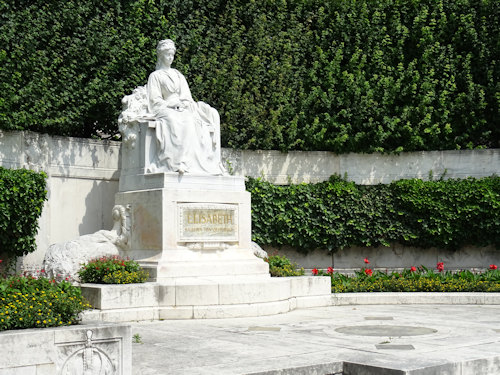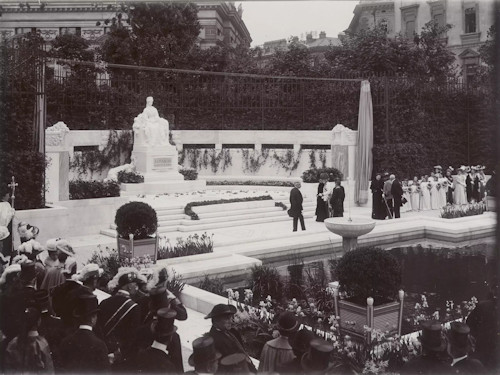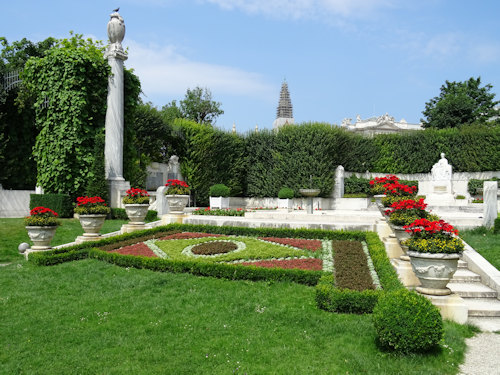
Even Emperors feel grief. Like Franz Joseph at the loss of his beloved Empress Elisabeth in 1898. The Sisi memorial dedicated to her memory fills a tract of the Volksgarten park.
- Finished in 1907, with water features, a statue, flower beds, and a tree-lined avenue
- Very central, yet strangely hidden, too
- Don’t miss the nearby rose garden
- See also:
The Sisi statue

(The building in the background is the Burgtheater: the national theatre)
Habsburg marriages tended to be of the arranged variety, with very few exceptions.
The one between Emperor Franz Joseph and Elisabeth (“Sisi”) was, however, a mix of political expedience and romance. He truly loved her. She may even have loved him in return (but, if so, certainly not to the same extent, sadly).
Despite Elisabeth’s ambivalence toward her husband and court responsibilities, and her regular absences from Vienna, she remains one of the great personalities in Habsburg history. Not least because of her famed beauty, somewhat rebellious nature, and enigmatic disposition.

(The marble statue by Hans Bitterlich)
No wonder, then, that she has an appropriate memorial statue and garden to her name.
Work began on this Sisi memorial in 1904, around six years after her assassination in Geneva and following an exhaustive tender process involving dozens of competitive ideas (and locations).
Completed in 1907 and officially unveiled on June 4th, the memorial fills a tract of the Volksgarten park right in the heart of the city.
The Kronen Zeitung newspaper (still going strong today) dedicated its first four pages to the unveiling, with the cover showing a picture of Franz Joseph and Maria Sophie (Elisabeth’s sister) at the event.

Unveiling of the memorial, photographed and published by the Verlag resp. k. u. k. Universitätsbuchhandlung R. Lechner (Wilh. Müller); Wien Museum Inv.-Nr. 239346/16; excerpt reproduced with permission under the terms of the CC0 licence)
Architect Friedrich Ohmann designed the surrounding area with the statue itself sculpted by Hans Bitterlich.
You might come across Ohmann’s work elsewhere. For example, his hands are behind the palm house at the edge of the Burggarten and the Zollamtssteg bridge familiar to fans of the movie Before Sunrise.
You find busts and reliefs by Bitterlich throughout the centre, and he also produced another notable memorial in Vienna: the Gutenberg monument.
(Find tickets and experience options for the palace and zoo)
The Empress sits in white marble, hands resting in her lap, the statue marked by a simple inscription that reads:
Elisabeth. Kaiserin von Österreich
The inscription translates as Elisabeth. Empress of Austria.
In front of the Empress…a pond and fountains, then stone vases of flowers and a lawn that stretches down a narrow tree-lined avenue past more sculpted flower beds and topiary until you reach Heldenplatz square.
Everything has a turn-of-the-century feel with a touch of Greece (perhaps a nod to Elisabeth’s love of that region). Sisi would have liked it.

(The tower beyond the hedge is the Rathaus: Vienna’s city hall)
Although surrounded by imperial landmarks, the memorial tract manages to remain a remarkably secretive and tranquil location. The kind of escape from Habsburg grandeur that Elisabeth sought for much of her life as an empress.
To be honest, I must have walked past it a hundred times without realising it was there.
If you visit, be sure to explore more of the Volksgarten, particularly the rose garden.
In summer, the roses form a glorious pageant of different colours; in winter, a strange landscape filled with tall stems, their tops encased in sacks of cloth, as if handcuffed and marching to a secret rebel hideout.
How to find the Sisi memorial
Follow the directions for the Volksgarten and the Rose Garden: leave the latter by the side furthest from the Ring boulevard. Then cross over to the other side of the large Theseus temple (see the map below).
Address: Volksgarten, 1010 Vienna